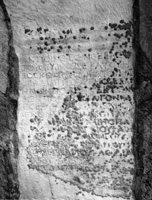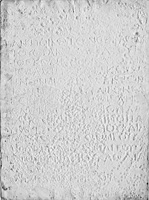 MAMA XI 66 (Sebaste)
MAMA XI 66 (Sebaste) 
Dedication of building or other public work to Philip the Arab
- Type of monument:
- Dedication of building work to emperor.
- Location:
- Kapaklar (Sebaste): in the base of the minaret.
- Description:
- Bomos of coarse whitish marble, upper and lower mouldings defaced, chipped left; the inscription partially overgrown with moss.
- Dimensions:
- Ht. 1.10; W. 0.47 (shaft); Th. 0.44 (shaft); letters 0.016-0.021.
- Record:
- Squeeze; line drawing; MB notebook copy; photograph (1956/34).
- Publication:
- Ramsay 1883: 414-5, no. 29; (Ramsay, Phrygia II 608, no. 498; IGR IV 635; SEG 42, 1203).
- Date:
- AD 248 (Year 332, Month 10 of Sullan era).
Αὐτοκράτορι 〚Καίσαρι〛
〚Μ(άρκῳ) Ἰουλίῳ Φιλίππῳ Εὐσεβ(εῖ)〛
〚Εὐτυχεῖ Σεβ(αστῷ) καὶ τῷ σύμ〛-
π̣αντι οἴκῳ τῶν Σεβαστῶ[ν]
5[ἔ]τους τλβ̣´ [μη(νὸς)] δεκάτου ἡ
Διοσκωμητ̣ῶ̣ν̣ κατοικία
[τ]ῆς λαμπροτάτης Σεβασ̣-
[τ]ηνῶν πόλεως ἐκ τῶν
[ἰ]δ̣ίων πόρων [τὸ] ἔ̣[ρ]γον κα[τ]-
10εσκεύ[ασε]ν̣ ἐ̣π̣ι̣μ̣ελησα-
μ̣ένων Μ̣(άρκου) [Ἐγν]ατ̣ί̣ου Γλυκ[ω]-
ν̣ιανοῦ [. . . c. 6 . . .] κ̣αὶ̣ Ποπλ[ί]-
ου Πετρων̣[ίου . c. 3 .]ι̣ου καὶ .[.]
ιου Ἐ̣γ̣ν[ατί]ου̣ Λ̣ό̣νγου κα[ὶ]
15Γ̣αίου Ἐγνατίου̣ Π̣αίτου κα[ὶ]
. .αν̣ου Ἐγνατίου Κλωδια-
νοῦ καὶ vac.
ΓΟΥ Σεβαστηνοί
Lines 2-3: 〚Μ. Ἰουλίῳ Φιλίππῳ| Γερμανικῷ καὶ τῷ σύμ〛 R(amsay 1883); 〚Μάρκῳ Ἰουλίῳ Φιλίππῳ| Εὐσ(εβεῖ) Εὐτ(υχεῖ) Σεβ(αστῷ) καὶ τῷ σύμ〛 Sijpesteijn 1992.
Line 5: [ἔ]τους τλ΄, [μηνὸς] R.
To Imperator Caesar M. Iulius Philippus Pius Felix Augustus and the whole house of the Augusti. Year 332, Month 10. The village of the Dioskometai of the most glorious city of the Sebastenoi, from their own revenues, constructed the work. The following were responsible for the construction: M. Egnatius Glykonianus... and Publius Petronius ...ius and ...ius Egnatius Longus and Gaius Egnatius Paetus and ...anus Egnatius Clodianus and... ?Sebastenoi.





This monument records the dedication to the emperor Philip the Arab of a public monument or building ([τὸ] ἔ̣[ρ]γον, line 9) by the village of Dioskome, on the territory of Sebaste. The lower part of the inscription is covered with moss and is extremely difficult to read. My restoration of the titulature of the emperor Philip the Arab in the erasure in lines 1-3 is a slight modification of that of Sijpesteijn 1992; this exact titulature is attested for Philip on a milestone between Ephesos and Magnesia (I.Ephesos 3164) and in a petition from Aragua in Phrygia (MAMA X 114; Hauken 1998: 140-61).
The inscription is dated to the tenth month of Year 332 of the Sullan era, the summer of AD 248: for the use of the Sullan era at Sebaste, see Leschhorn 1993: 265-7. Numbered months were in use both at Sebaste (MAMA XI 80 (1956/36); probably 79 [1954/26]) and at neighbouring Traianopolis (MAMA XI 90 [1956/30]).
The settlement of Dioskome is described as a village (κατοικία, line 6) ‘of’ the city of Sebaste, that is to say, a dependent community on the territory of Sebaste (Schuler 1998: 274; for the interchangeability of the terms κώμη and κατοικία, cf. Schuler 1998: 33-4). Unfortunately, the location of Dioskome is uncertain; the findspot of the inscription, the village of Kapaklar, seems too far north to have lain on the territory of Sebaste (Buresch 1898: 169-70; TIB Phrygien 234, s.v. Dioskōmē). It is possible that Dioskome is to be identified with the ancient site near the modern village of Kırka (TIB Phrygien 234, s.v. Dioskōmē). There is some slight evidence that Dioskome might already have existed in the Hellenistic period, before the synoecism of Sebaste, with the name Diospolis vel sim. (Le Rider 1990: 700).
The monument (whatever it was) was constructed by the village ‘from its own funds’ (ἐκ τῶν [ἰ]δ̣ίων πόρων, lines 8-9); compare e.g. I.Ephesos 3271 (ἐκ τῶν τῆς κώμης πόρων), and see Schuler 1998: 244-7.
One of the five individuals responsible for the erection of the monument carries the gentilician Petronius, and the remaining four all carry the gentilician Egnatius. Both families are prominent in the public epigraphy of this region. A Publius Petronius Epigenes is attested at Akmoneia already during the reign of Augustus (MAMA XI 99 [1955-109]); on the Egnatii of Akmoneia, see Thonemann 2010. Egnatius is one of the many gentilicians carried by the polyonymous honorand of the Akmoneian inscription MAMA XI 101 (1955/99). It is no surprise to find members of the two families acting together in our inscription, since the families are known to have been connected by marriage. An inscription from neighbouring Diokleia dated to AD 196/7 (Ramsay, Phrygia II 660, no. 615; IGR IV 664) mentions a certain Q. Petronius Capito Egnatianus and his son Marcus; the cognomen Egnatianus derives from his mother’s nomen Egnatia (Salomies 1992: 61 n.2).
Lines 17-18 are puzzling. There are no traces of inscribed letters after καί in line 17, but the three letters ΓΟΥ at the start of line 18 are most easily interpreted as belonging to a sixth personal name in the genitive case. The ethnic Σεβαστηνοί in line 18 has been added in a different hand; its relation to the rest of the inscription is uncertain.